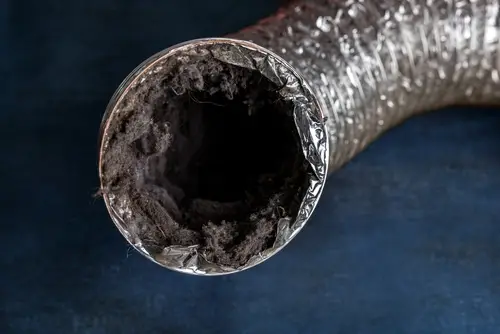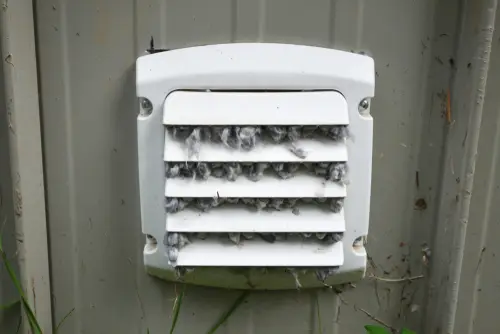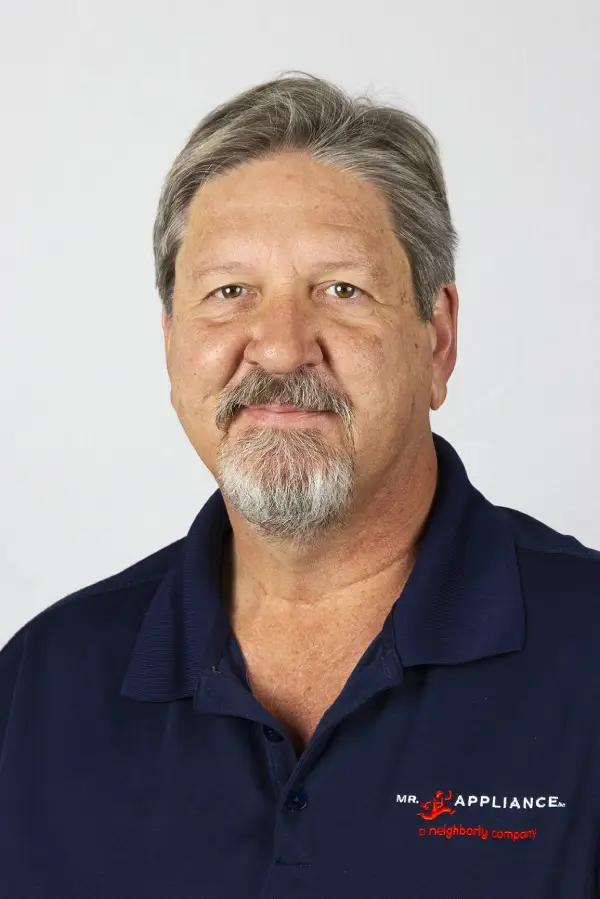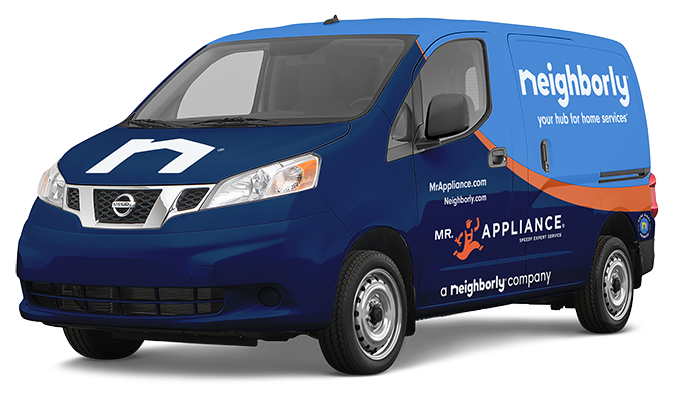
Stuart Pyburn, a Mr. Appliance® expert with 36 years of experience in the appliance repair industry, explains the dangers of a clogged dryer vent, the warning signs to watch for, and the benefits of professional dryer vent cleaning.Key reasons to clean your home’s dryer vent:
|
Your clothes dryer is one of the hardest-working appliances in your home. But while you’re busy cleaning your clothes, a hidden hazard could be building up deep inside your dryer and its venting system: lint.
In this guide, Mr. Appliance® expert Stuart Pyburn explains why dryer vent cleaning is a critical home maintenance task, as well as what you need to know about dryer vent cleaning to protect your home, your appliance, and your wallet.
- About the Dryer Vent Cleaning Expert Stuart Pyburn
- FAQs About Dryer Vent Cleaning
A Clogged Vent Is More Than an Inconvenience
Many homeowners believe that cleaning the lint filter after each load is all the maintenance a dryer needs. This is a dangerous misconception.
The small, flexible screen in your dryer traps most of the lint, but not all of it. Microfibers, pet hair, and other debris inevitably get pulled past it into the dryer's internal ductwork, the flexible vent hose behind it, and the rigid duct that runs through your walls to the outside vent.
Over time, this buildup creates a dense blockage that chokes off airflow. This single problem creates a cascade of other, more serious issues.
Fire hazards
The U.S. Fire Administration reports that dryers are the leading source of structural fires, with “failure to clean” being the most common cause. This is the most crucial reason to take dryer vent cleaning seriously.
Mr. Appliance expert Stuart Pyburn, a 36-year veteran of the appliance industry, explains that “lint is very flammable and could catch fire.” When airflow is blocked, the dryer's high-limit safety thermostats are forced to work overtime, which can cause the heating element to ignite the trapped, tinder-dry lint.
Stuart notes that “manufacturers recommend cleaning the lint filter after each load, and the dryer and vent annually—or more if you do a lot of laundry."
Needless wear and tear on your appliance
A clogged vent is like forcing your dryer to breathe through a straw. The motor, blower wheel, and heating element are all put under immense strain as they try to push hot, moist air through a blockage.
Stuart Pyburn, a Mr. Appliance expert in dryer vent cleaning, explains the potential long-term damage: "Lint will build up in your dryer and clog up the rollers and other parts, making them wear out faster."
Overheating and strain can lead to premature failure of the most expensive parts of your machine, including:
- Burned-out heating elements
- Failed thermal fuses
- Worn-out drum rollers and bearings
- Seized motors
These are costly repairs that are almost entirely preventable with routine vent maintenance.
Skyrocketing utility bills
When your dryer can't exhaust hot, humid air efficiently, it has to run longer. A single 45-minute cycle might turn into 90 minutes or even two full cycles to dry one load of laundry.
That extra runtime directly translates to a higher energy bill. Whether you have an electric or gas dryer, you’re paying extra every single month for an appliance that’s struggling to do its job. A professional cleaning can often pay for itself in just a few months with energy savings alone!
Other hidden dangers of clogged dryer vents
When hot, moist air or dangerous fumes can't escape because of a clogged dryer vent, they create other significant risks as well, including:
- Mold and mildew: The trapped moisture has to go somewhere, including into the drywall behind your dryer, creating a perfect environment for mold and mildew to grow.
- Carbon monoxide (for gas dryers): A blocked vent can prevent the byproducts of combustion from escaping your home, potentially allowing dangerous levels of carbon monoxide (CO) to build up in your laundry room.
7 Warning Signs Your Dryer Vent Is Clogged

How do you know if you have a dangerous dryer vent blockage? Your dryer will typically give you warning signs before a catastrophic failure.
According to 36-year appliance expert Stuart Pyburn, signs of a clogged dryer vent may include “lint around the dryer on the floor, the appliance taking longer to dry your clothes, and even a burning smell around the dryer.” Keep an eye out for:
- Longer drying times: This is the #1 sign of a blocked vent. If you suddenly need to run cycles twice, don't blame the dryer—check the duct.
- A burning smell: A dusty, burning odor indicates that the dryer is overheating, and lint inside the machine or vent may be scorching. Stop using the dryer immediately and call a dryer vent cleaning professional.
- The dryer is hot to the touch: The outside of the dryer cabinet should be warm, but never alarmingly hot. If the top or sides feel scorching, it's a sign that heat is trapped inside.
- Lint piles behind the dryer: Expert Stuart Pyrburn points this out as a key indicator. If you pull the dryer away from the wall and find “lint bunnies” or a carpet of fluff, it means air is leaking out of a poorly-connected or clogged duct.
- The outdoor eye test: The exterior vent flap should open and close freely when the dryer is running. If it's caked with lint or doesn't move, you have a blockage. Stuart Pyburn gives this simple tip: “Look at the vent outside your home. If you see lint stringers clogging up or hanging from the vent, it’s past time to clean it out.”
- Excessive humidity: Does your laundry room feel like a sauna every time you run the dryer? This means the hot, moist air isn't escaping and is being forced back into your home.
- Error codes: Many modern dryers have sensors that will detect high temperatures or low airflow and display a “check vent” or “flow sensor” error code on the panel.
If you notice any of these signs, it's time to take immediate action. Call your local Mr. Appliance team for professional dryer vent cleaning.
Dryer vent cleaning myths vs. facts
Let's bust a few common myths that can put your home at risk.
|
Myth |
Fact |
|
"My lint filter catches everything. I don't need to clean the vent." |
Your lint filter is designed to catch only part of the lint produced by your dryer. The remaining lint bypasses the filter and builds up in the vent, where it mixes with moisture, forming a dense, flammable blockage. |
|
"A little extra drying time is just a minor annoyance." |
Extra drying time is the number one warning sign of a clogged vent, which means your dryer is overheating, wasting energy, and stressing out components like the heating element and motor. This drastically shortens its lifespan and creates a fire risk. |
|
"The white, flexible vinyl duct behind my dryer is fine." |
White vinyl ducts are not up to code in most locations. Not only are they highly flammable, but their ribbed accordion design traps lint, which accelerates the formation of dangerous blockages. |
|
"As long as I don't smell burning, I'm safe." |
A burning smell is the final warning sign that a fire is already imminent. The primary danger (combustible heat buildup) occurs long before you can smell lint scorching. |
Your Action Plan for a Safe Dryer
Homeowners can take proactive steps to prevent a dryer lint fire. However, keep in mind that dryers are complex appliances that should be handled by qualified professionals to protect yourself and your home. Contact your local Mr. Appliance for dryer vent cleaning near you.
Clean your dryer lint filter frequently
First, follow the manufacturer's #1 rule: Clean your lint filter after every single load. While it doesn’t catch everything, the lint filter is still your best defense against lint buildup.
Expert tip: Dryer sheets leave an invisible, waxy film on the filter that can block airflow even when the lint trap looks clean. Once every few months, take the filter to the sink and scrub it with a soft brush, hot water, and a little dish soap.
The pitfalls of DIY dryer vent cleaning
When faced with a clogged vent, it's tempting to head to the hardware store, buy a "dryer vent cleaning kit," and try to tackle the job yourself. While the DIY spirit is commendable, this is one job where "good enough" can be dangerous.
Those flexible brush kits are often flimsy and simply not powerful enough to handle the job. They can lead to a false sense of security or, in some cases, make the problem even worse. Further, extensive ductwork can be very difficult to clean effectively without professional-grade tools.
Before attempting to clear the vent yourself, consider the common failures and risks of a DIY approach:
- Ineffective and damaging tools: Consumer-grade brushes on flexible rods are often inadequate and can even damage the ductwork if they break or get stuck.
- Incomplete cleaning: A DIY brush just loosens lint; it doesn't extract it. You may just be pushing a blockage further down the line or compacting it near a turn.
- Missing the real problem: The most dangerous lint buildup may be inside the dryer cabinet, packed around the motor and heating element. A vent brush kit doesn't address this at all.
- Creating a new hazard: The final step—reconnecting the dryer—is a critical failure point. Poor vent connections, kinked ducts, and gas leaks can cause significant safety risks.
Trust the professionals for true peace of mind
This is not a task to cut corners on. Your home and family's safety are at stake. A professional dryer vent cleaning service is more than just a cleaning—it's a comprehensive safety inspection.
Our service professionals have the proper tools, experience, and training to:
- Safely disconnect and reconnect all dryer types, including gas models.
- Use powerful, professional-grade equipment to thoroughly clean the entire vent run, no matter how long or complex.
- Clean the hazardous lint inside your dryer's cabinet.
- Identify and replace unsafe or damaged ducts (like flammable white vinyl) with code-compliant metal venting.
- Ensure your system is running safely and efficiently before we leave.
Don't risk a fire or a damaged clothes dryer. If it's been more than a year since the last duct service, or if you notice any warning signs, contact your local Mr. Appliance team for residential services near you.
Contact Mr. Appliance for Reliable Dryer Vent Cleaning
That load of laundry that won't seem to dry isn't a problem with your dryer—it's a cry for help. A clogged vent is a threat to your home, your appliance, and your budget. By following the simple maintenance tips from dryer vent cleaning expert Stuart Pyburn, you can ensure your dryer runs safely and efficiently for years to come.
Don't wait for a warning sign. If it's been more than a year or if you're experiencing any symptoms of a clog, contact your local Mr. Appliance team to schedule dryer vent cleaning services. Our service professionals have the tools and expertise to clear your vents, protect your home, and give you valuable peace of mind.
All Mr. Appliance franchises are locally owned and operated and may offer fewer or more services than those listed here. To learn more about the dryer vent cleaning services offered in your area, contact the Mr. Appliance nearest you for details or a customized on-site assessment.
FAQs About Dryer Vent Cleaning
Integrity, dependability, and exceptional customer service are the qualities that make Mr. Appliance the go-to resource for appliance maintenance and repairs. All independently owned and operated Mr. Appliance locations are committed to providing the top-notch service you expect from an industry leader, including using our expertise and years of experience to answer your questions. Here are answers to some of the most frequently asked questions about dryer vent cleaning.

